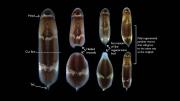Chop a three-banded panther worm in half, and the head and tail will swirl around as if nothing had happened. Even more astonishing, a few days later, the halves will grow to become two complete and almost indistinguishable worms.
Loeb associate professor of the natural sciences Mansi Srivastava has studied this process of healing and regeneration for more than a decade. Together with members of her research group, she has been working to uncover the molecular and cellular mechanisms underlying whole-body regeneration, and tracing their evolutionary history. Understanding both these aspects of regeneration, she believes, could aid in efforts to develop the field of human regenerative medicine.
Srivastava chose to study the three-banded panther worm because this tiny, carnivorous Bermuda native is especially adept at whole-body regeneration: able to heal and then recreate an entire organism from even a small fragment of its body. Moreover, the species is sufficiently similar to planarians, worms widely studied in the field of regeneration biology, that scientists can make comparisons between the two species, whose last common ancestor lived 550 million years ago. If there are similarities in the molecular mechanisms they use to regenerate, Srivastava explains, identifying and investigating these shared elements could lead to an understanding of the fundamental principles controlling this feat.
An advance in this direction came in 2019 when her research group reported the discovery of a “pioneer factor,” a molecular agent responsible for initiating the cascade of genetic signals necessary for regeneration. In the moments after an injury, she explains, cells around the damaged site sound an alarm by generating proteins that activate the choreography of regeneration. But what intracellular factor causes the genes encoding those proteins to switch on? How does an incomplete animal know what is missing, and how to recreate it? “Who” or what decides how to proceed?
Her team probed these questions using a technique known as ATACseq that allowed them to zoom in on the structure of chromatin—the packaging material of cellular DNA. They focused on regions of the chromatin structure that opened up soon after amputation. These sites marked genes likely activated in response to injury. By analyzing the commonalities among multiple regions of open chromatin across many cells found near the damage site, Srivastava and colleagues were able to identify one such “decision-maker,” or factor responsible for the observed changes in the products of these activated genes. Known as EGR, the protein proved crucial for regeneration: when the researchers turned off its production, many of the genes that should have been switched on weren’t—and the worm never regenerated.
This work provided “a broad look,” Srivastava says, at the early steps following amputation. Her team is currently developing a more detailed picture of these molecular events. To do so, they have applied the same analysis of the chromatin structure to individual cells of the worm. By looking at chromatin changes within single cells, they hope to learn exactly how the process that directs regeneration unfolds.

By tagging a single potentially pluripotent cell (above, at far left) with a red fluorescent protein, researchers can watch as it divides, eventually becoming a complete worm.
Courtesy of Mansi Srivastava
At the same time, Srivastava has turned her attention to the raw material the worms use to regenerate tissues, a form of adult stem cell called a neoblast. In response to amputation, these typically dormant cells “wake up” and undergo rapid bursts of division. A sort of cellular alchemy ensues, she explains: like embryonic stem cells, which are active during development, the neoblasts turn into “neurons, muscles, skin, whatever you need.” This ability to become any cell type, known as pluripotency, is a well-described feature of embryonic stem cells. But panther worms are somehow able to maintain pluripotency of neoblasts into adulthood.
By investigating the cellular origins of the worms’ embryonic and adult pluripotent stem cells, and characterizing the differences and similarities between the two, Srivastava hopes to learn how neoblasts persist and reawaken, and why human and other mammalian stem cells are limited in their regenerative capacities.
Using ultraviolet light to tag cells of interest and follow them during their life cycle, her team has made significant progress toward identifying the cellular lineage that gives rise to stem cells during the worm’s early development. “We now want to use that same approach in adults,” she says, to understand how the worms make and then maintain a neoblast, to “keep it hanging out, happily pluripotent, in its body. I don’t think my work is going to help anyone grow a limb five years from now,” she adds, “but I do think it could lead to an understanding of pluripotency, and how genomes are regulated during regeneration.” That could lead to breakthroughs in the nascent field of human regenerative medicine.









